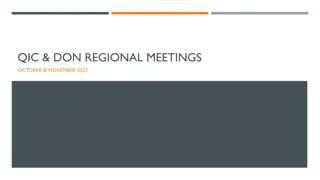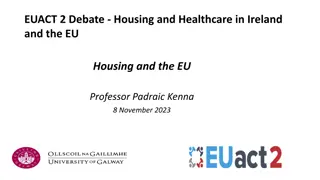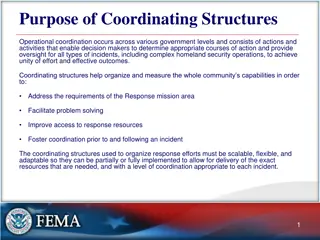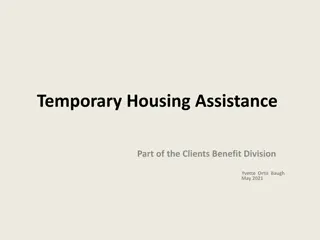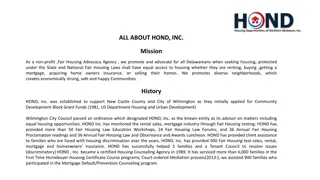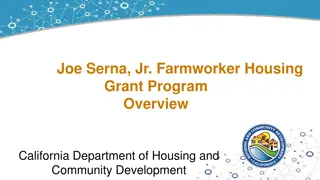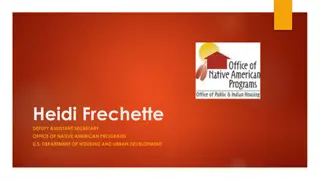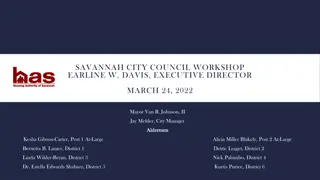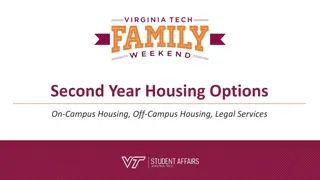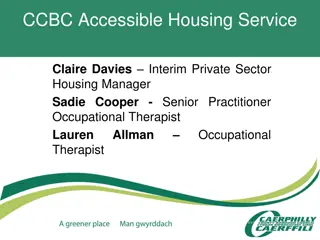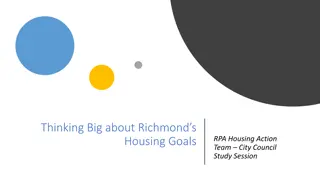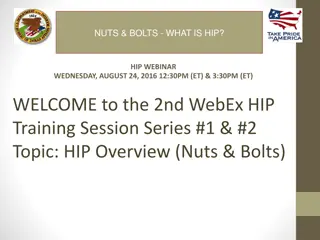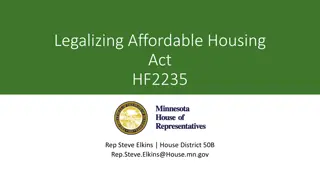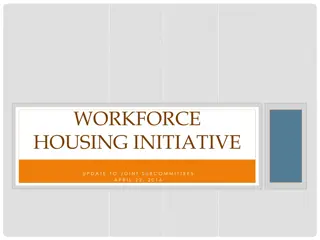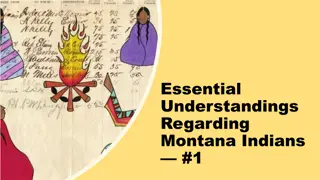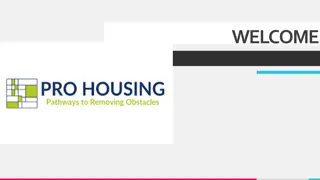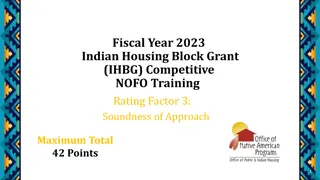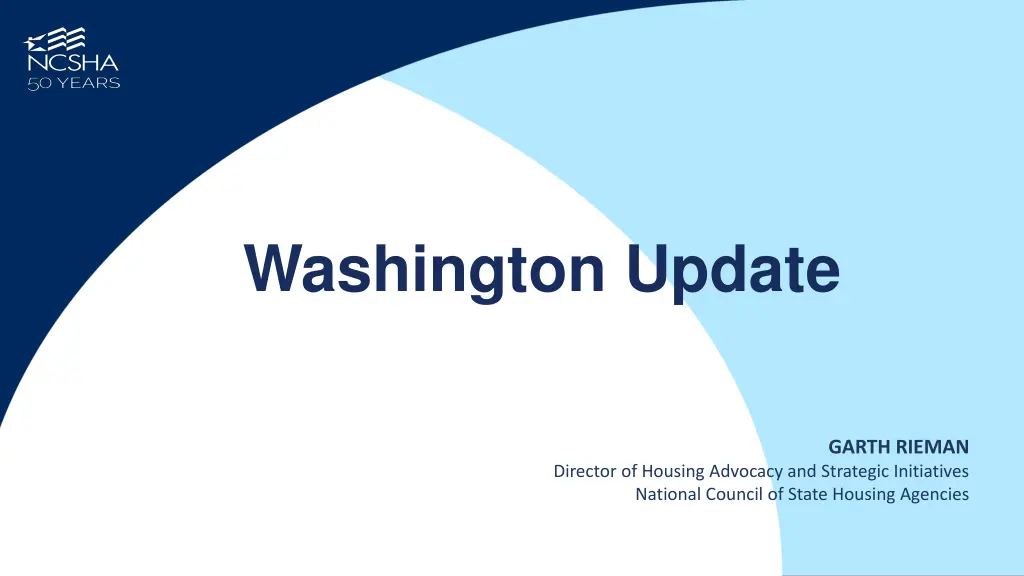
One Big Beautiful Bill Act and Budget Timeline Updates
President Trump signed the One Big Beautiful Bill Act into law, impacting housing credit authority and bonus depreciation. The Act extends Opportunity Zone tax incentives, New Markets Tax Credit program, and clean energy tax credits. Additionally, the budget and appropriations timeline highlights key dates such as the reconciliation bill signing and appropriations actions. Stay informed on the latest developments in housing advocacy and strategic initiatives.
Download Presentation

Please find below an Image/Link to download the presentation.
The content on the website is provided AS IS for your information and personal use only. It may not be sold, licensed, or shared on other websites without obtaining consent from the author. If you encounter any issues during the download, it is possible that the publisher has removed the file from their server.
You are allowed to download the files provided on this website for personal or commercial use, subject to the condition that they are used lawfully. All files are the property of their respective owners.
The content on the website is provided AS IS for your information and personal use only. It may not be sold, licensed, or shared on other websites without obtaining consent from the author.
E N D
Presentation Transcript
Washington Update GARTH RIEMAN Director of Housing Advocacy and Strategic Initiatives National Council of State Housing Agencies
One Big Beautiful Bill Act (OBBBA) President Trump signed OBBBA into law July 4. Includes a permanent 12 percent increase in 9 percent Housing Credit authority beginning in calendar year 2026 and Permanently lowers the bond financing threshold from 50 to 25 percent for 4 percent Housing Credit projects financed with tax- exempt private activity bonds that have an issue date after December 31, 2025. According to the Joint Committee on Taxation, these provisions represent an estimated $15.7 billion in tax expenditure.
One Big Beautiful Bill Act (OBBBA) Permanent 100 percent bonus depreciation for qualified properties, which should benefit Housing Credit investors and thereby help boost pricing. Does not include basis boost increases for Housing Credit properties in rural and Native American areas included in the House version. Will help produce and preserve up to an additional 1.22 million affordable homes over the next decade, according to Novogradac. No changes to the tax exemption for private activity bonds.
One Big Beautiful Bill Act (OBBBA) Permanently extends and reforms the Opportunity Zone tax incentive, increases the targeting of designations and financial incentives to rural areas, allows new zone designations every ten years, focuses benefits on lower income communities, and adds reporting requirements. Permanently extends the New Markets Tax Credit program, currently set to expire at the end of 2025. Accelerates the phase-out and termination of clean energy tax credits implemented in the Inflation Reduction Act but more slowly than the phase-out schedule in the original House bill. Mortgage insurance and interest deductions made permanent, SALT cap raised temporarily, other changes.
Budget and Appropriations Timeline July 4: President signs reconciliation bill into law May 2: Administration delivers skinny budget Rural Housing (Ag) Approps Markups September 30: End of FY25 June 2: Administration delivers full budget proposal April 10: Congress adopted budget resolution July 14, 17: House THUD Approps Markups April 11 July 4: Congress drafting tax/reconciliation bill Late May Oct: FY 26 Appropriations Committee Action 5
FY 26 Appropriations Action House has marked-up USDA rural housing funding bills. Senate Committee markup today. House HUD bill markups July 14 and 17. Senate HUD markups later this summer.
FY26 Presidents Budget Proposal Consolidates HUD rental assistance programs (tenant-based and project-based Section 8, public housing, Sec. 202, and Sec. 811) under a new state block grant and reduces funding by $26.7 billion. Places a two-year limit on assistance for able- bodied adults. Consolidates CoC and HOPWA into the ESG program and reduces funding by $532 million. Eliminates CDBG, HOME, NAHSDA Native American program funding, HUD s self-sufficiency programs, PRO Housing, and FHIP fair housing programs.
FY 2026 Budget Chart for Select HUD Programs ($ in millions) FY25 Full Year Continuing Resolution FY26 Budget Request HUD Programs FY25 Budget Request FY25 House Committee FY25 Senate Committee 0 Community Development Block Grant (CDBG) 2,930 3,300 3,300 3,430 0 HOME Investment Partnerships Program (HOME) 1,250 500 1,425 1,250 4,024 Homeless Assistance Grants 4,060 4,060 4,319 4,051 0* Housing Choice Vouchers 32,756 32,272 35,260 32,041 0* Housing for the Elderly (Section 202) 931 931 1,046 931 0* Housing for Persons with Disabilities (Section 811) 257 257 257 257 0* Project-Based Section 8 16,686 16,595 16,654 16,490 0 Housing Counseling Assistance 57.5 57.5 57.5 57.5 8 *To be consolidated under new proposed state block grant program and funded at $26.7 billion
FY26 Presidents Budget Proposal USDA Rural Housing Programs $74 million increase for rural rental assistance programs to prevent default on USDA-underwritten multifamily housing direct loans. Eliminates RHS single-family direct loans, self-help housing grants, and rural housing vouchers. Treasury Programs Eliminates new CDFI discretionary awards. Remaining funding would support oversight and closeout of prior awards, maintain CDFI certification, and support NMTC administration and Bond Guarantee program HHS Programs Eliminates LIHEAP
House Rural Housing Appropriations Bill House Appropriations Committee advanced the FY26 Agriculture, Rural Development, Food and Drug Administration, and Related Agencies bill. Provides $25 billion for USDA s programs, $1.2 billion or 4.2 percent less FY25 and a $2 billion increase compared to the President s Budget Request. Most rural housing programs would retain similar funding to current FY25 levels.
House Rural Housing Funding Section 502 Single-Family Housing Direct Loans would receive $880 million, equal to FY25 funding levels. Section 502 Single-Family Housing Guaranteed Loan level would be $25 billion, same as FY25. Section 515 Multifamily Housing Direct Loan Program would receive $60 million, equal to FY25. Section 538 Multifamily Housing Guaranteed Loan Program would receive $800 million, same as FY25.
House Rural Housing Funding Section 521 Rental Assistance Program would receive $1.72 billion, seven percent, or $107 million, more than FY 25. For renewals of existing RA. Also authorizes USDA to continue, for another year and up to an additional 1,000 units, decoupling rental assistance from Section 515/516 properties with expiring mortgages, preserving the affordability of these units. Section 542 Rural Voucher Assistance Program would receive $48 million, equal to FY25. Rental Preservation Demonstration Program (MPR) would receive $30 million, a $4 million, or nearly 12 percent, decrease in funding from FY25.
Other Administration Priorities Reduce the size and scope of the federal government Staffing cuts at federal agencies Contract and grant cancellations Remove regulatory barriers Impose Administration Executive Orders and directives through grant agreements Assert control over certain independent agencies
HOME Reauthorization and Reform Possibilities Eliminate or raise thresholds for cross-cutting requirements: BABA Davis-Bacon NEPA choice-limiting actions Section 3 Replace CHDO set-aside with a nonprofit set-aside Increase eligible income thresholds Add or remove eligible activities 14
HOME Investment Partnerships Program Reauthorization and Improvement Act (S. 948/H.R. 2031) Highlights Increase authorized funding level to $5 billion. Changes to CHDO set-aside. Raise cap on operating assistance to 10 percent. Allow for pro-rated repayment for noncompliance. Increase administration resources to 15 percent. Eliminate 24-month commitment deadline. Allow national standard for inspections. Eliminate certain resale restrictions (reassigned service members, heirs/beneficiaries). Modify PJ qualification threshold. Establish HOME loan guarantee (mirror CDBG Section 108). 15
NCSHA-Endorsed Standalone Tax Bills Affordable Housing Credit Improvement Act (AHCIA), S. 1515, H.R. 2725 Neighborhood Homes Investment Act (NHIA), S. 1686, H.R. 2854 Affordable Housing Bond Enhancement Act (AHBEA), S. 1511, TBD in House Note: We still want more cosponsors for these bills!
AHCIA Highlights Expands multifamily Housing Bond recycling authority. Expands the Housing Credit volume cap by 50 percent above the current level (building 12.5 percent increase into baseline and accounting for inflation during two-year phase-in). Lowers the bond financed-by threshold from 50 to 25 percent. Allows states to award a 30 percent basis boost to Housing Bond-financed developments; all projects in rural and Native American areas. Establishes a 50 percent basis boost for ELI units in properties that reserve at least 20 percent of units for ELI households. Makes the Credit a more effective tool for preservation. Streamlines program rules like the student rule and requirements related to casualty loss and AIT in bond-financed properties. Ensures protections for veterans and survivors of domestic violence, dating violence, and human trafficking. 17
AHBEA Highlights Adopts long-standing NCSHA priorities for strengthening MRBs and MCCs. Increases the MRB home improvement loan limit from $15,000 to $75,000 and indexes the limit for inflation. Permits states to re-designate carryforward authority and use it for either single-family or multifamily housing during the carryforward period. Allows MRBs to be used to fund refinancing loans. Extends the MCC expiration period from two years to four and the MCC revocation period from one year to two. Changes the MCC benefit calculation to a simple percentage of the original loan balance. Reduces the time period for the MRB and MCC recapture tax from nine years to five. Eliminates the MCC lender reporting requirement. Shortens the MCC comment period from 90 days to 30. Mandates IRS reporting on states use of PAB cap. 18
NHIA Highlights Authorizes the Neighborhood Homes Credit. Tax credit for production of single-family affordable housing in distressed areas. State-administered. Eligible area maps available at neighborhoodhomesinvestmentact.org. 19
Housing Finance Reform FHFA Director Bill Pulte and other Administration officials considering proposals. Possible exit from conservatorship. Other administrative reforms ongoing. NCSHA focus on HFA initiatives, affordable housing goals, Duty to Serve requirements, and broad access to liquidity.
Questions and Discussion With additional questions or comments, contact grieman@ncsha.org or visit www.ncsha.org 21

